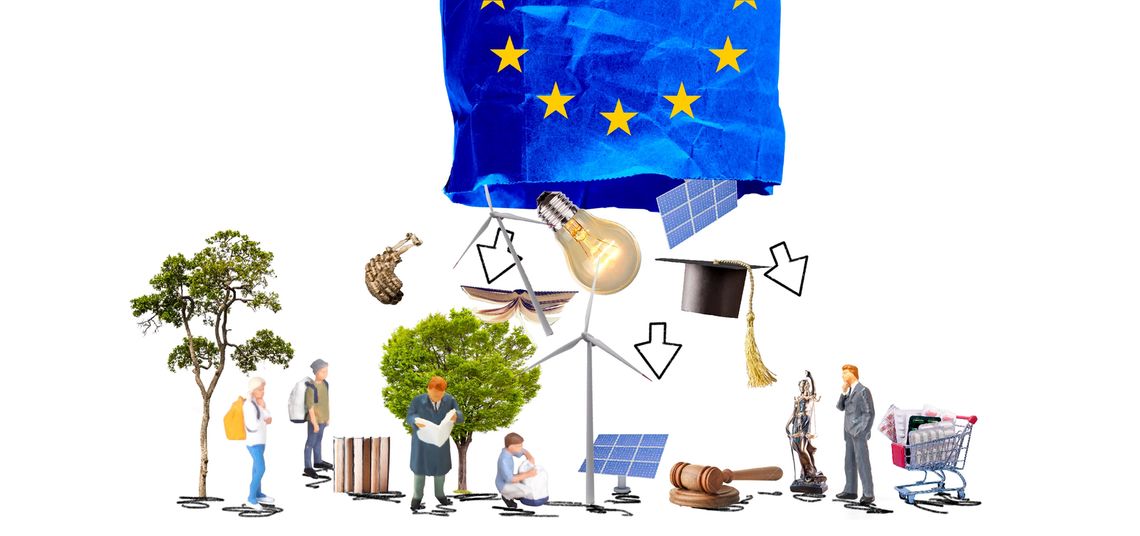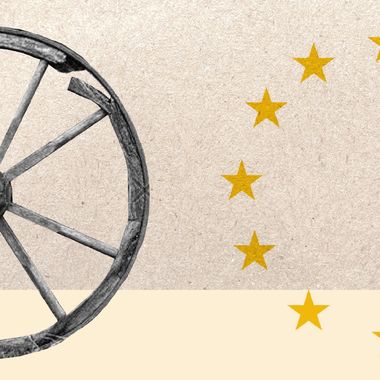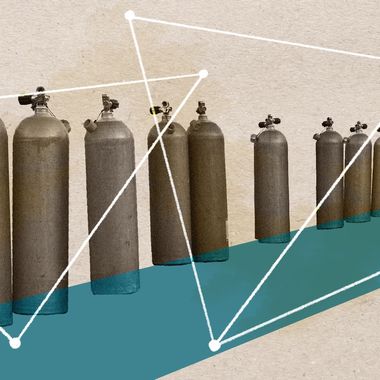Thu Jul 15 2021 · 6 min read
The EU’s “Building Back Better” Policy Gaining Momentum in Armenia
politics

By Anna Barseghyan

Illustration by Armine Shahbazyan.
After staying on the sidelines of the 2020 Artsakh War, which was indeed a challenge for the EU and its position in the region, the EU is back with a renewed and impressive strategy. On July 2, 2021, the European Commission adopted "Recovery, resilience, and reform: post-2020 Eastern Partnership priorities" which could be a real game-changer in the six-country Eastern Partnership region that includes Armenia, Georgia, Azerbaijan, Ukraine, Moldova and Belarus. The document is a Five-Year Agenda for the eastern neighbors, which is going to replace the 20 deliverables for 2020. It goes hand in glove with the “The Eastern Partnership beyond 2020: Reinforcing resilience - an Eastern Partnership that delivers for all” strategy and implements the main priorities mentioned in the document:
1. Working together for resilient, sustainable and integrated economies
2. Working together for accountable institutions, the rule of law and security
3. Working together toward environmental and climate change resilience
4. Working together toward a concrete digital transformation
5. Working together for fair and inclusive societies
Starting in 2016, resilience and principled pragmatism became the guiding principles of the EU's foreign policy in general. They were reflected in all the subsequent documents adopted for the Eastern Partnership policy framework. However, the latest “Recovery, Resilience and Reform” document could be assessed as the most pragmatic one, which could have a tangible influence in the region and significantly strengthen the EU’s position as one of its key players. The EU is trying to widen its influence from being just a normative power to also offering significant financial incentives to the region. One of the possible reasons for the policy change could be the growing Russian influence in the region, based not only on military presence but also soft power tools and powerful economic leverage.
The adoption of the document was followed by a visit of the Commissioner for Neighbourhood and Enlargement, Olivér Várhelyi, to the South Caucasus from July 6-9. It was the commissioner's first mission to Georgia, Azerbaijan and Armenia. In each of the countries, the Commissioner presented the Five Year Plan that the EU has for them.
The two pillars of the documents are investment, to be supported by an economic and investment plan and governance which will help to strengthen resilience and generate concrete benefits to the citizens of the Eastern Partnership countries. To achieve the objectives, the EU's various tools and modalities will be used, including the new Neighbourhood, Development and International Cooperation Instrument (NDICI)-Global Europe instrument and the Team Europe initiatives, cross-border cooperation programs and the partners’ own investments. To maximize the impact and visibility of the agenda, top ten targets and flagship initiatives were identified for the six Eastern Partnership countries:
1. Investing in competitive and innovative economies
-
Support to 500,000 SMEs (20% of all SMEs in the region)
2. Investing in sustainable and smart connectivity
-
Build or upgrade 3000 km of priority roads and railways in line with EU standards
3. Investing in people and knowledge societies
-
70,000 individual mobility opportunities for students and staff, researchers, young people and youth workers
4. Investing in the rule of law
-
All high-level officials (judiciary, prosecution, parliament, law enforcement, public administration) declare their economic assets and these declarations are verified
5. Investing in security and cyber resilience
-
To strengthen the framework in place for identifying and addressing hybrid threats; strengthen partners' capacities to increase cyber resilience and tackle cyber crime, including through fully implementing the Council of Europe Budapest Convention on cyber crime
6. Investing in the environment and climate
-
Give access to another 3 million people to safe water services. The air quality will be monitored and improved in 300 cities
7. Investing in sustainable energy
-
250,000 households reduce energy consumption by at least 20% through energy efficiency
8. Investing in digital transformation
-
80% of households have affordable access to high-speed internet
9. Investing in inclusive, gender-equal and diverse societies, and strategic communication
-
2,500 local civil society organizations, 120 independent media outlets and 2,000 journalists supported
10. Investing in health resilience
-
850,000 health workers will be vaccinated and/or benefit from improved therapeutics, equipment and working conditions
Through these targets, the EU will support the partners’ socio-economic recovery and “building back better” by pursuing green and digital transitions. The flagship initiatives for each country are different, based on the needs of the partners. Armenia’s share of the pie is very generous. During his visit to Yerevan on July 9, European Commissioner for Neighborhood and Enlargement Olivér Várhelyi stated that, in addition to the €1.6 billion announced investments, the EU will mobilize another €1 billion through other sources. The amount is unprecedented, considering the fact that, during 2019, the EU’s foreign direct investments in outward stocks was €1.3 billion, inward stocks were €300 million and the balance is €1 billion.[1] However, it should be noted that this assistance can take the form of loans, grants or investments. It may not always be beneficial for the Armenian government to take on the whole package as the public debt at the end of 2020 reached 63.5%, which exceeds the established threshold of 60%.
The above mentioned €2.6 billion could be used on five flagship programs:
-
Flagship 1: Supporting a sustainable and innovative and competitive economy – direct support for 30,000 SMEs
-
Flagship 2: Boosting connectivity and socio-economic development – the north-south corridor
-
Flagship 3: Investing in digital transformation, innovation, science and technology
-
Flagship 4: Building resilience in the southern regions
-
Flagship 5: Investing in a green Yerevan – energy efficiency and green buses
One of the novelties of the program is building resilience in the southern regions, mainly in Syunik. According to the document, the EU will invest €80 million in the Syunik region using a mix of grants, loans and guarantees. The choice of the region is justified by the decentralization policy adopted by the government of Armenia and the disproportionate development between the capital and the remote regions. As it is mentioned in the document, Syunik “was particularly affected by the recent hostilities, and has witnessed an influx of displaced people in need of housing, jobs and access to education. Priority sectors could include housing, infrastructure, tourism, agriculture, education, health, renewable energy and support for local SMEs.”
Interestingly, the EU's interest in the Syunik region increased right after the 2020 Artsakh War as new Russian peacekeeping troops were deployed to the region and neighboring Artsakh. When Artsakh was a frozen conflict zone without Russian troops, interest among western countries was low. The same applies regarding their policy and treatment of Artsakh in comparison to South Ossetia, for example.
However, with the new policy and the new agenda, the EU is trying to counterbalance the influence of other regional players and make headway for strengthening its future position. During the 2020 Artsakh War, the EU was a silent observer in the region as both Russia and Turkey expanded their influence in accordance with their imperial pasts. However, with the new concrete steps, the EU is trying to show its willingness to take part in regional developments, breathing new life into the impact of the Eastern Partnership. The amount of the overall investment package for the agenda also indicates that the wing of the EU countries, led by Germany, who are more in favor of deepening relations with the Eastern Neighbors instead of the southern neighbors is gaining clout. The EU is openly signaling a new era through its pragmatic entrance to the region with solid budget support.
[1] Foreign Direct Investment (FDI) stocks measure the total level of direct investment at a given point in time, usually the end of a quarter or of a year. The outward FDI stock is the value of the resident investors' equity in and net loans to enterprises in foreign economies. The inward FDI stock is the value of foreign investors' equity in and net loans to enterprises resident in the reporting economy.
More from the author
Armenian-EU Energy Cooperation
By Anna Barseghyan
One of the most important dimensions of Armenian-EU cooperation is the energy sector. The EU has expressed a willingness to support Armenia in designing an energy strategy and policy, including security and diversification of the energy supply.
Armenia-EU Relations: Understanding CEPA
By Anna Barseghyan
The Comprehensive and Enhanced Partnership Agreement between Armenia and the EU came into force on March 1, 2021. Will it serve as a stepping stone to develop and extend the scope of the partnership?
From Conflict Manager to Silent Observer
By Anna Barseghyan
The 2020 Artsakh War put to the test long-held assumptions about the roles of neighbors and global players in the region. Some maintained and reinforced their significance and role in the region, others raised their importance and some were invisible.
Southern Gas Corridor Brings Azerbaijani Gas to the EU
By Anna Barseghyan
The operation of the Southern Gas Corridor raises the geopolitical significance of Azerbaijan and Turkey, contributing to the further isolation of Armenia from regional projects. The EU seems to limit its concern about human rights violations and war crimes in Artsakh to mere lip service.
EU Adopts New Powerful Tool to Punish Global Human Rights Violations
By Anna Barseghyan
In December 2020, the EU passed the Action Plan on Human Rights and Democracy, equipping its foreign policy arsenal with a powerful new tool to protect human rights. Armenians should be paying close attention to how it will be used.







